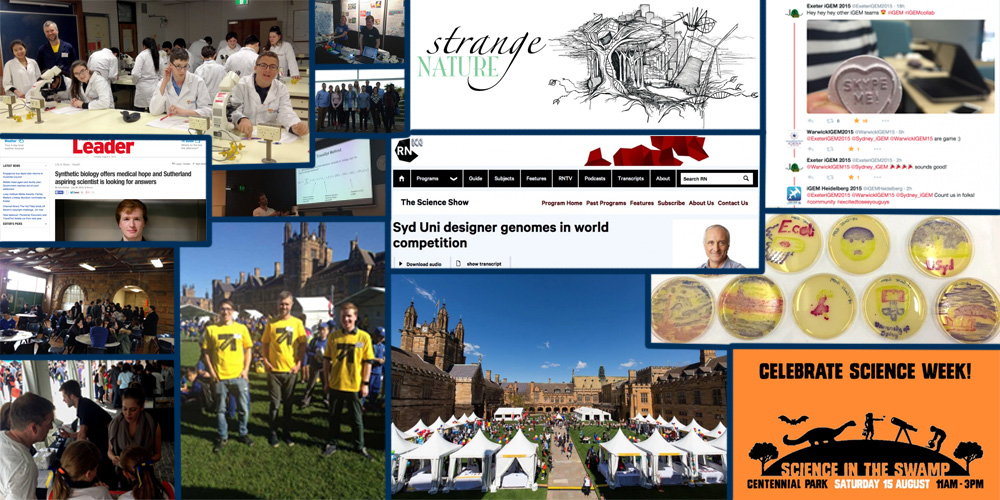Team:Sydney Australia/Practices
Human Practices Overview
In our Human Practices project we investigated and promoted the many aspects of Synthetic Biology which occur outside of the laboratory:
First, we developed and implemented educational activities, via both outreach and the media, which helped to inform tens of thousands of people about our project and Synthetic Biology as a whole.
Second, we collaborated with iGEM teams from around the world, helping to foster the diverse and inclusive community that this competition has built.
Third, we developed a business plan, which illustrates the potential for implementing our genetic machines in the long-term as commercially viable products.
Finally, we investigated the environmental impact of our project, and how it could help to shape more efficient industry practices for the future.
Education
Motivation & Analysis - Without public trust and understanding we believe it will be all but impossible to realise the remarkable advances synthetic biology promises. Therefore, motivated by the abundant misconceptions and lack of understanding of synthetic biology in our community, we decided to create an educational human practices project. This project used a range of platforms to ably target all groups within our community, ensuring that appropriate information was delivered at an appropriate level from appropriate sources. Analysis and results of our educational project reveal we achieve this to a great extent: Our members discussed synthetic biological technologies face-to-face with almost twenty thousand people in our outreach component, and through media channels we engaged an audience numbering in the millions.
Outreach - Via face-to-face outreach we were able to foster informed discussions of Synthetic Biology, and to inspire a future generation of researchers. With activities ranging from facilitating a national Synthetic Biology writing competition to presenting at Science in the Swamp, and from teaching sessions in schools to speaking at Rotary clubs and student societies, we were able to reach a diversity of audiences, and share details of our project.
Media - Through media channels, which ranged from national radio stations to Sydney newspapers, and from teacher and student magazines to Facebook and Twitter, we were able to build the profile, and facilitate understanding of, Synthetic Biology. Bringing these discussions into the public sphere is essential for the future of this field, and helps to encourage the interest and participation of members throughout our communities.
Collaboration
In order to facilitate growth and mate-ship in the the vibrant international iGEM community we engaged with 20 teams from around the world. Our collaborative exercises ranged from an Australian iGEM meet-up to exchange of plasmids with other teams, and from sharing of experimental protocols to participation in a Synthetic Biology reality TV show. We hope that by encouraging cooperation throughout the iGEM community the efforts of all will be amplified, and we look forward to meeting all of our new friends at the Jamboree!
Industry Business Model
We believe that our project has the potential to be developed into a "real world" product that could be utilised by large organisations currently concerned with chemical synthesis. Thus, we found it useful to develop a business plan for our project, which could inform implementation if the opportunity arose. Our research into the market and industry revealed important insights which influenced the design and construction of our work.
Environmental impact
The chemically synthetic production of ethylene oxide is incredibly detrimental to the environment on multiple levels. The emissions it releases, the excessive water it uses, and the non-renewable reagents it requires negatively contribute to the vast environmental issues faced by society. The use of ethylene oxide is not going to decrease, and thus we found it imperative to design a project that could produce the necessary substance whilst minimising the negative impact. The environmental impact aspect of our project is explored on the project description page, where we discuss current practices and the need for future innovation.


